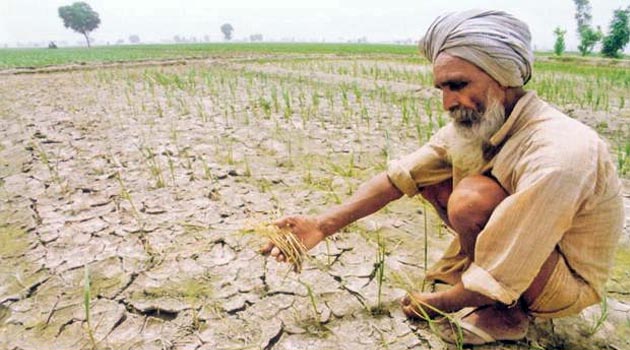Has the Land Reforms of India helped the poor ?
The Land reforms should remain an essential element of national agricultural and rural development strategies not only because land-based agricultural occupation must continue to provide livelihoods to a vast majority of rural population. In this paper it is proposed to deal with land reforms in India. What measures have been taken by the Government, and how should it help the poor people.
“ Our land is more valuable than your money. It will last forever. It will not even perish by the flames of fire. As long as the Sun shines and the waters flow, this land will be here to give life to men and animals.”
Voice of the Farmers
Introduction
Before Nineteen forty seven, the Indian agrarian society was governed by semi-feudal principles. The land tenure was classified into three categories ie., zamindary, mahalwari and ryotwari. These systems gave rise to social injustice. After independence of India, a congenial agrarian structure had to be evolved to accelerate the process of development.
Pre-Land Reforms
In pre-independent India the land tenure was classified into three categories. Land tenure refers to the system of land ownership and management.
First category was zamindari system. In1793 Cornwallis introduced zamindari system in Bengal under this system a new class of zamindars were declared to be owners of the land and they had to collect land revenue of which one-tenth to one –eleventh was retained by them as their remuneration, and the rest was handed over to the company under the permanent of 1993, the zamindari was declared the absolute owner and proprietor of his estate (land). While the land revenue demand was fixed, the rent realized by the landlord form the tenant cultivators was left unsettled and unspecified This system provided the zamindar with the opportunity to exploit the cultivator to the limit of the letter’s capacity with the growth of population, extension of cultivation, rise in prices and the growing scarcity of land, the zamindar’s position improved. On account of the right of subinfeudation of estates and holdings by the zamindars, the competition for land increased and there emerged a chain of middlemen and intermediary rent – receiving interests between the original landlord and the cultivator, whose position was that of a mere tenants at the will or mercy of the zamindar. The tenants were rack-rented, impoverished, and suffered from oppression at the hands of zamindars. The tenants continued to live in an increasingly worsening condition.
Second category was Mahalwari system. Under this system, the land was made with the while village community jointly and severally. This it was a two-fold settlement . First, the ownership and occupancy right was reserved for the individual peasants and cultivation was to be done individually. Second, the peasants were jointly responsible for paying the land revenue to the state .
Third category was Ryotwari system. Under this system the ryots were given the owner–ship and occupancy rights in land and they were directly and individually responsible for the payment of land revenue to the state. Under these systems, the cultivator did not get a faire share of the agricultural produce. The skewed distribution of land, insecurity of tenure, high incidence of landlessness, high rents and rural indebtedness. These systems gave rise to social injustice. Thus, after independence the Govt. of India has introduced the land reforms.
In the post- independence period it was felt that a congenial agrarian structure had to be evolved to accelerate the process of development . Since the inception of the planning process, the objectives of planning in a developing economy are to achieve maximum production and to social justice. It is intended to reduce economic inequalities and to prevent exploitation of the under privileged classes. To accelerate development of agriculture, it is also necessary to bring about a reorientation of the social institutions which act as impediments in the path of rural development. For the development of an underdeveloped economy, land reforms have a special significance, because the prevalence of feudal system and rack- renting and existence of the small sized forms and insecurity of tenancy rights act as serious obstacles to the growth of agriculture.
Land Reforms
The Land reforms were given special place in the Indian five year plans. A comprehensive land policy was set-out in the plans and the land reform measures undertaken in pursuance thereof fall broadly into five classes. Firstly, Abolition of intermediaries; Secondly, tenancy reforms; Thirdly, ceilings on holdings; Fourthly, consolidation of holdings, and Fifthly, updating and preparation of land records,
Firstly, the Legislative measures for abolition of intermediary tenure with Uttar Pradesh with the zamindari Abolition and Land Reform Act of 1950. This was followed by legislations is other states. The pattern of land ownership is a key element in ushering change. Since the Zamindari Abolition Act was hailed as an agrarian revolution. This Act abolished the old rights of zamindars and Jagirdars and put a ban on further acquition of land. Abolition of intermediary tenures was made on payment of compensation to the land owners. The peasantry was legally freed from all illegal exactions in cash, kind and services.
The Land records were created and survey and settlement was carried out in these areas. The land holdings were demarcated on the basis of the individual as the unit.
Secondly, the major components of Tenancy reforms were rent should not exceed one-fifth to one-fourth to gross produce. All tenance should be declared non-resumable and permanent except is certain specified circumstances ie., ensuring security of tenure. In respect of non-resumable land, the landlord- tenant relationship should be terminated by conferring ownership rights on tenants. The most important and probably the most significant provision for regulation of tenancy has been that which gave a greater measure of security to the tenants. Such security provides incentive to carrying out improvements in the land, increase its productivity and enable the tenant to retain an equitable share of the production. The security of tenure steps were prescription of a minimum period of tenancy, restrictions on ejectment, restrictions of ejectment , reinstatement of wrongly ejected tenants, tenants right for compensation for improvement, restrictions on resumption for personal cultivation, regulation of voluntary surrenders, tenant’s right to acquire ownership and tenant’s secondary rights to homestead land, grazing land, trees etc.
The ultimate objective of tenancy reform is to confer ownership right on tenant’s and share-croppers who are tilling the soil so that the landlord tenant relation as a production condition is broken and absentee landlordism completely eliminated.
Thirdly, the ceiling legislation has been passed in all states, though the implementation thereof has made progress in some states only. After the imposition of the ceilings 7.2 million hectares of land were declared of which 4.65 million hectares were distributed and 0.89 million hectares have been reserved for specific public purposes. Therefore, efforts will have to be made to detect the surplus land, hitherto unavailable, to distribute the existing surplus expeditiously and ensure that the allottees retain the possession of land.
Fourthly, consolidation of holdings was attempted in isolated experiments in different parts of the country. It was to press with consolidation when not less than one half the permanent holding not less than two – thirds of the occupied area agreed to it .It was to be binding on all the other permanent right holders. But if the requisite proportions did not agree, no compulsion could be used. The benefits of consolidation in the development process, however, cannot be under estimated. Consolidation of holdings would provide an opportunity to recast and re-build the record of rights needed for orderly flow of credit, apart from other benefits. An integrated approach to soil and water management would also be facilitated by consolidation that would contribute to better production and productivity or even for more rational use of irrigation potential already created.
Fifthly, the information available in the record of rights is not of a uniform pattern. In every state the record of rights is expected to contain information in respect of each plot or survey number, its area, the name of the owner, the class of land, and the land revenue etc.
With a thunderous enthusiasmly started the Land reforms, but soon the vitality of this enthusiasm was lost. The Implementation of land reforms were failed. Broadly, land reforms were conceived in a proper perspective but being riddled with loopholes, they have brought little Justice to the rural people.
Professor M.L. Dantwala said that “ By and large Land reforms in India enacted so for and those contemplated in the near future…. are in the right direction; and yet due to lack of implementation the actual results are for form satisfactory” .
The main reasons for poor implementation of land reforms- lack of political will; lukewarm and often apathetic attitude of the bureaucracy, absence of up-to-date land records, absence of pressure from below because the poor peasants and agricultural workers are passive, unorganized and in articulative, and legal hurdles in the way of implementation of reforms. In many parts of the country, the record, the record of rights are out of date .
Organisation of the poor peasantry into strong trade unions is a pre- condition of land reform. Indeed, the share – cropper is at the mercy of land lord for his very existence. The Indian Judiciary should not be involved at any stage in the implementation of land reforms.
Govt of India has taken steps
Due to this problems Govt. of India has taken some steps. The sixth plan mid-term appraisal states that “In west Bengal share-croppers are being registered in the record of rights under a special programme to enable them to get the benefit of security of tenancy …. The mechanism evolved in this regard in west Bengal for the recorded share –croppers and assignee of ceiling surplus land may be adopted with suitable modifications in other areas also.”
The seventh plan reveals that “ Land reforms have been recognised to constitute a vital element both interms of the antipoverty strategy and for modernisation and increased productivity in agriculture. Redistribution of land could provide a permanent asset base for a large number of rural landless poor for taking up land–based and other supplementary activities. Similarly, consolidation of holdings, tenancy regulation and updating of land records, would widen the access of small and marginal landholders to improved technology and inputs and thereby directly lead to increase in agricultural production.”
The Ninth plan states that “All possible efforts would be made to detect and redistribute the surplus land to enforce ceiling laws with firmness…. Absentee landlordism must be eliminated by plugging the legal loopholes, tightening the implementation machinery and providing for speedy adjudication of disputes in revenue courts…. Rights of tenants and share-croppers need to be recorded and security of tenure provided to them This alone would provide incentive for increasing investment in agriculture, as experience in certain parts of the country has shown. Preference should be given to poor, especially women with respect to wastelands and common property resources.”
Suggestions
- Augmenting the surplus land over the existing ceiling on land holdings as well as from government sources for distribution to the landless poor.
- Encouraging investments by tenants for raising productivity and incomes.
- Restoring to the tribals lands appropriated by non- tribals. Priority should be given perfect and genuine land records .
- Government should give financial assistance to tenants with less interest and to introduce some financial schemes with some subsidy.
- Political will should be created. For this land less, small and marginal formers represent actives should be given representation local Panchayat bodies.
- The poor cultivators may be provided legal aid upto the level of Supreme Court.
- The Lok Adalats should be empowered to dispose of Land reform litigations.
- Finally, the Government has provide social Justice and contribute to increasing the agricultural
Conclusion
Gandhiji Stated that, “ Earth (Land) provides enough to satisfy every man’s need, but not every man’s greed ”. The Land reform measures to a large extent succeeded in breaking down the traditional zamindars and the absentee landlords. Today, the occupant of land is directly responsible to the state for the payment of land revenue.
The interactions between poverty, food security and resource rights are starting to bring about a refocusing of national agenda on the revival of agrarian reform. In the new strategy of anti-poverty programmes, endowment of income generating assts on those who have none or little of these is emphasised. Hence Land reform measures are being integrated with anti-poverty package of programmes and are recognised to constitute a vital element both interms of anti poverty strategy and modernization and increased productivity in agriculture.
Author
Dr.K.Srinivasulu
M.A, M.Phil, Ph.D., Faculty of Economics
N.B.K.R.Science & Arts College, Vidyanagar




